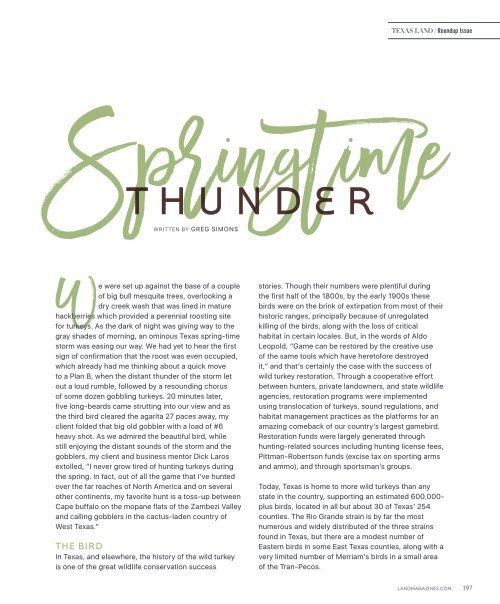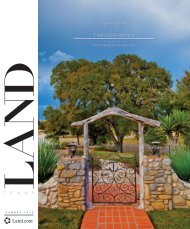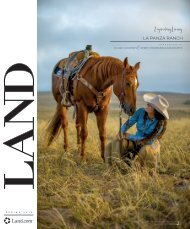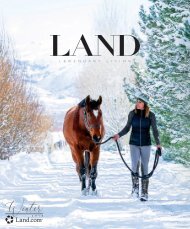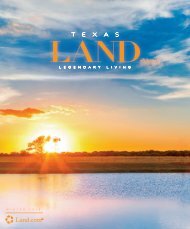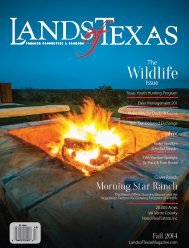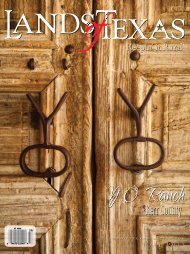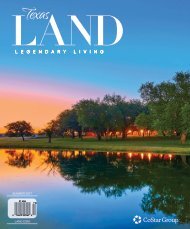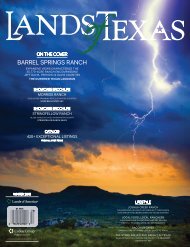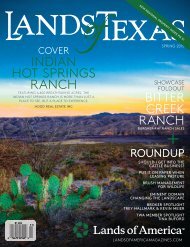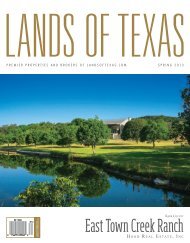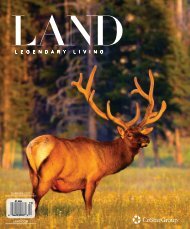You also want an ePaper? Increase the reach of your titles
YUMPU automatically turns print PDFs into web optimized ePapers that Google loves.
TEXAS LAND / Roundup Issue<br />
Springtime<br />
THU NDER<br />
WRITTEN BY GREG SIMONS<br />
We were set up against the base of a couple<br />
of big bull mesquite trees, overlooking a<br />
dry creek wash that was lined in mature<br />
hackberries which provided a perennial roosting site<br />
for turkeys. As the dark of night was giving way to the<br />
gray shades of morning, an ominous <strong>Texas</strong> spring-time<br />
storm was easing our way. We had yet to hear the first<br />
sign of confirmation that the roost was even occupied,<br />
which already had me thinking about a quick move<br />
to a Plan B, when the distant thunder of the storm let<br />
out a loud rumble, followed by a resounding chorus<br />
of some dozen gobbling turkeys. 20 minutes later,<br />
five long-beards came strutting into our view and as<br />
the third bird cleared the agarita 27 paces away, my<br />
client folded that big old gobbler with a load of #6<br />
heavy shot. As we admired the beautiful bird, while<br />
still enjoying the distant sounds of the storm and the<br />
gobblers, my client and business mentor Dick Laros<br />
extolled, “I never grow tired of hunting turkeys during<br />
the spring. In fact, out of all the game that I’ve hunted<br />
over the far reaches of North America and on several<br />
other continents, my favorite hunt is a toss-up between<br />
Cape buffalo on the mopane flats of the Zambezi Valley<br />
and calling gobblers in the cactus-laden country of<br />
West <strong>Texas</strong>.”<br />
THE BIRD<br />
In <strong>Texas</strong>, and elsewhere, the history of the wild turkey<br />
is one of the great wildlife conservation success<br />
stories. Though their numbers were plentiful during<br />
the first half of the 1800s, by the early 1900s these<br />
birds were on the brink of extirpation from most of their<br />
historic ranges, principally because of unregulated<br />
killing of the birds, along with the loss of critical<br />
habitat in certain locales. But, in the words of Aldo<br />
Leopold, “Game can be restored by the creative use<br />
of the same tools which have heretofore destroyed<br />
it,” and that’s certainly the case with the success of<br />
wild turkey restoration. Through a cooperative effort<br />
between hunters, private landowners, and state wildlife<br />
agencies, restoration programs were implemented<br />
using translocation of turkeys, sound regulations, and<br />
habitat management practices as the platforms for an<br />
amazing comeback of our country’s largest gamebird.<br />
Restoration funds were largely generated through<br />
hunting-related sources including hunting license fees,<br />
Pittman-Robertson funds (excise tax on sporting arms<br />
and ammo), and through sportsman’s groups.<br />
Today, <strong>Texas</strong> is home to more wild turkeys than any<br />
state in the country, supporting an estimated 600,000-<br />
plus birds, located in all but about 30 of <strong>Texas</strong>’ 254<br />
counties. The Rio Grande strain is by far the most<br />
numerous and widely distributed of the three strains<br />
found in <strong>Texas</strong>, but there are a modest number of<br />
Eastern birds in some East <strong>Texas</strong> counties, along with a<br />
very limited number of Merriam’s birds in a small area<br />
of the Tran-Pecos.<br />
LANDMAGAZINES.COM<br />
197


